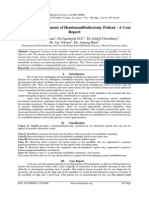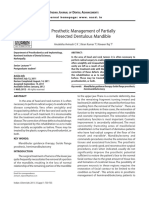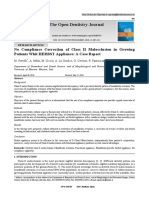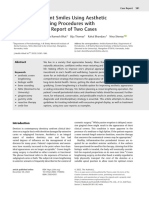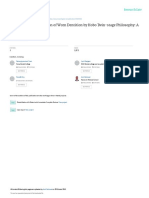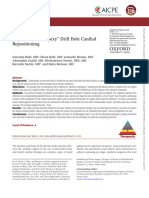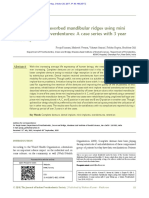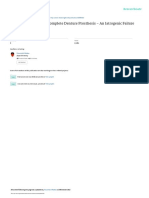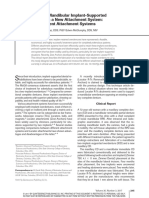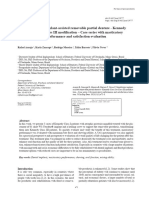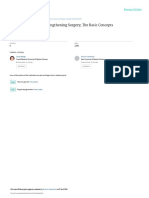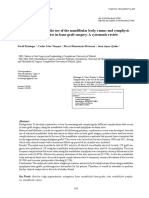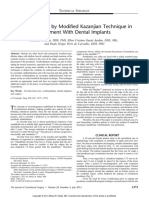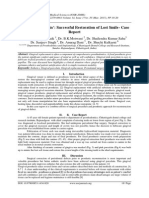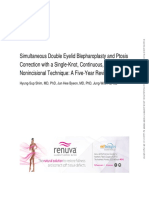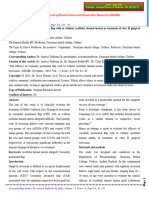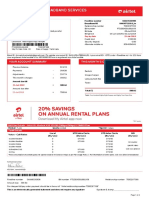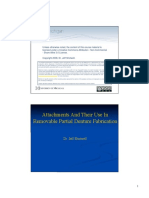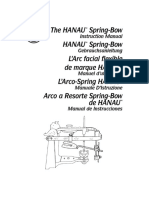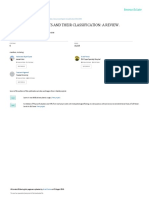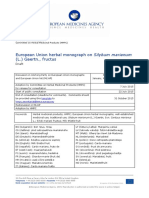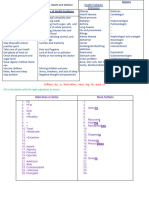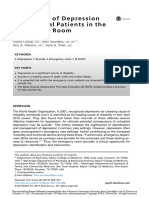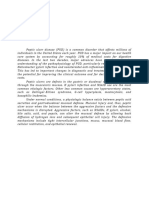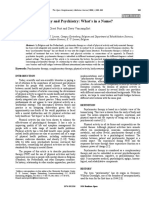WJCC 5 384 PDF
WJCC 5 384 PDF
Uploaded by
Vivek ShankarCopyright:
Available Formats
WJCC 5 384 PDF
WJCC 5 384 PDF
Uploaded by
Vivek ShankarOriginal Title
Copyright
Available Formats
Share this document
Did you find this document useful?
Is this content inappropriate?
Copyright:
Available Formats
WJCC 5 384 PDF
WJCC 5 384 PDF
Uploaded by
Vivek ShankarCopyright:
Available Formats
WJ CC World Journal of
Clinical Cases
Submit a Manuscript: http://www.f6publishing.com World J Clin Cases 2017 October 16; 5(10): 384-389
DOI: 10.12998/wjcc.v5.i10.384 ISSN 2307-8960 (online)
CASE REPORT
Prosthodontic management of hemimandibulectomy
patients to restore form and function - A case series
Deenadayalan Lingeshwar, Rajendran Appadurai, Ujjayanthi Sswedheni, Challa Padmaja
Deenadayalan Lingeshwar, Rajendran Appadurai, Ujjayanthi Abstract
Sswedheni, Challa Padmaja, Government Royapettah Hospital,
Chennai 600014, India Surgical resection of mandible owing to benign, malignant
neoplasm, osteoradionecrosis is common. The resection
Author contributions: All authors equally contributed to the can be total or segmental depending on the lesion. Loss
treatment and writing case report. of mandibular continuity causes deviation of remaining
mandibular segment towards the resected side and
Institutional review board statement: This case report was rotation inferiorly due to muscle pull and scar contracture
exempt from the Institutional Review Board standards at Govern
affecting mastication and esthetics. Surgical reconstruction
ment Royapettah hospital, Chennai, India.
may not be always possible. Prosthetic rehabilitation plays
Informed consent statement: A letter of permission had been a major role in these patients. This case series describes
obtained from the patients no matter if the article appears in the different types of guiding flange (GF) prosthesis with
published or in the online journal. modifications for three hemimandibulectomy patients at
different time interval after surgery. The article details
Conflict-of-interest statement: There is no conflict of interest GF prosthesis combined with physiotherapy to correct
or financial interests, direct or indirect, that exist or may be deviation of mandible thereby improving mastication,
perceived to exist for individual contributors in connection with esthetics and speech and thus enhancing the quality of
the content of this paper.
life.
Open-Access: This article is an open-access article which was
selected by an in-house editor and fully peer-reviewed by external Key words: Hemimandibulectomy; Mandibular deviation;
reviewers. It is distributed in accordance with the Creative Guiding flange prosthesis; Palatal ramp
Commons Attribution Non Commercial (CC BY-NC 4.0) license,
which permits others to distribute, remix, adapt, build upon this © The Author(s) 2017. Published by Baishideng Publishing
work non-commercially, and license their derivative works on Group Inc. All rights reserved.
different terms, provided the original work is properly cited and
the use is non-commercial. See: http://creativecommons.org/ Core tip: Mandible is a significant structure in lower
licenses/by-nc/4.0/
third of face constituting to esthetics and functions like
Manuscript source: Unsolicited manuscript speech, swallowing and mastication. Surgical resection
owing to various reasons disrupts these functions. Both
Correspondence to: Dr. Deenadayalan Lingeshwar, Assistant form and function should be considered in rehabilitating
Professor, Government Royapettah Hospital, Westcott Road, hemimandibulectomy patients. This article describes
Opposite YMCA Ground, Chennai 600014, prosthetic rehabilitation that comprises of different types
India. grhdentalpublications@gmail.com of guiding flange prosthesis with modifications for three
Telephone: +91-74-18314035 hemimandibulectomy patients at different time interval
after surgery.
Received: May 23, 2017
Peer-review started: May 24, 2017
First decision: July 11, 2017
Revised: July 27, 2017 Lingeshwar D, Appadurai R, Sswedheni U, Padmaja C. Prosthodontic
Accepted: August 2, 2017 management of hemimandibulectomy patients to restore form and
Article in press: August 3, 2017 function - A case series. World J Clin Cases 2017; 5(10): 384-389
Published online: October 16, 2017 Available from: URL: http://www.wjgnet.com/2307-8960/full/v5/
WJCC|www.wjgnet.com 384 October 16, 2017|Volume 5|Issue 10|
Lingeshwar D et al . Restoration of function for hemimandibulectomy patients
i10/384.htm DOI: http://dx.doi.org/10.12998/wjcc.v5.i10.384
INTRODUCTION
Mandible is a significant structure in lower third of face
constituting to function and esthetics. It is a single bone
that creates peripheral boundaries of the floor of the
mouth, facial form (lower third), speech, swallowing,
mastication and respiration. Disruption of mandible due
to trauma, surgical resection for benign and malignant
neoplasm disrupts any of these functions. Both form
and function should be considered in rehabilitating Figure 1 Midline shift and loss of occlusal contact.
hemimandibulectomy patients. Loss of mandibular
continuity causes deviation of the remaining mandibular
segments towards the defect and rotation of the
Retentive partes (Clasp)
mandibular occlusal plane inferiorly due to muscle pull
and scar contracture. Mandibulectomy with radical
neck dissection increases this deviation. This results in
facial disfigurement, loss of occlusal contact, in many
cases, loss of lip competency for saliva control and
[1]
to initiate the swallowing process . Literature shows
techniques to correct mandibular deviation that can
vary from intermaxillary fixation with elastics, palatal or
mandibular guiding flange (GF) prosthesis anchored on
[2]
natural teeth or the dental flange . The GF is probably
the simplest and most useful in maintaining position
[3]
of the remaining jaw . This article describes different Figure 2 Mandibular guiding flange prosthesis.
types of GF prosthesis with modifications for three
hemimandibulectomy patients at different time interval
after surgery. Type Ⅲ Dental stone (Goldstone, mfg. by ASIAN
CHEMICALS). Interocclusal record was made with
modelling wax (the Hindustan dental products) by
CASE REPORT asking the patient to move the mandible away from
Case report 1 resected site as far as possible and manually guiding
A 36 years old male patient was referred to the hospital the mandible to centric occlusion. This record was
with the history of carcinoma left buccal mucosa transferred to a mean value articulator. Three clasps
for which he underwent hemimandibulectomy and were made using 21 gauge wire - “C” clasp on canine
modified radical neck dissection one month back and and premolar; adams clasp on molar for retention
reconstructed with pectoralis major myocutaneous purpose. Considering the amount of deviation and
flap. Patient complained of difficulty in mastication and reduced mouth opening, mandibular GF prosthesis was
speech. fabricated on the nondefect side using autopolymerising
Extra oral examination revealed facial asymmetry acrylic resin (DPI Cold Cure pink; Dental products of
and deviation of mandible towards the resected site India). After applying sufficient separating medium,
and the deviation increased on opening the mouth. the resin was added on buccal and lingual aspect of
The mouth opening was reduced to 25 mm. Intra oral nondefect side of mandible and on the buccal side the
examination revealed partially edentulous mandible extension was till the maxillary buccal vestibule. The
and loss of occlusal contact (Figure 1).The mandibular prosthesis was tried in patient mouth and checked for
defect was classified as Cantor and Curtis Class Ⅱ that is retention and stability. It was trimmed and adjusted so
[4]
lateral resection of the mandible distal to cuspid . It was that the mandible is guided to centric occlusion without
noted that mandible can be guided to centric occlusion delivering excessive force to maxillary teeth. Acrylic
manually but the patient could not achieve this position resin was added little by little to the guide flange until
consistently on his own. So the treatment objective was there was smooth guidance of the mandible to proper
to correct the deviation of mandible and to restore proper occlusion without any interference. The prosthesis
occlusion for mastication. was finished and polished (Figure 2). After insertion
Impressions were made with modified stainless of the prosthesis, midline coincided and occlusion was
steel stock tray and irreversible hydrocolloid (Tropicalgin, achieved (Figure 3). The patient was advised to use
IDS DENMED Pvt. Ltd.) followed by pouring cast with the GF throughout the day except at night and during
WJCC|www.wjgnet.com 385 October 16, 2017|Volume 5|Issue 10|
Deenadayalan L et al . Restoration of function for hemimandibulectomy patients
Figure 3 Correction of deviation after insertion of the prosthesis. Figure 5 Occlusion contacts established with prosthesis.
Extension to
prevent supra
Occlusion eruption
stabilization
Flange
Figure 4 Palatal guiding flange prosthesis. Figure 6 Palatal guiding flange prosthesis with functionally generated
acrylic occlusal table on non-resected site and stabilization ramp for
resected side.
meals. Physiotherapy exercises were also insisted. It
included maximum mouth opening and grasping the
chin to move the mandible away from surgical side. This this position consistently. Since mouth opening was
will help in reducing trismus, minimize scar contracture normal compared to previous case, an acrylic GF on
[1]
and improve occlusion . Review after a month, there maxilla was planned as interim prosthesis.
was trivial reduction in the deviation. Hence, palatal GF Impression, cast, interocclusal record and articulation
prosthesis was made which wouldn’t affect esthetics. were made following the same procedure as in case
report 1. Palatal GF prosthesis was planned for this
case considering the stability of prosthesis, esthetics,
Case report 2
A 49 years old male patient presented to the hospital occlusion and downward rotation of mandible. The guide
with the complaint of difficulty in mastication and flange extended till the lingual sulcus on the nondefect
facial disfigurement for the past three years owing to side. The prosthesis was tried in patient mouth. The
carcinoma left buccal mucosa for which he underwent inclination of the guide flange was adjusted until it
composite resection of mandible and reconstructed guided the mandible to centric occlusion (Figure 4). But
with Pectoralis major myocutaneous flap following as both maxillary and mandibular teeth were attrited,
preoperative chemotherapy and radiotherapy. On clinical functional cusps were worn out. The mandibular teeth
examination, there was deviation of remaining mandible glided beyond centric occlusion. To prevent this and to
towards the resected site and also downward rotation train the patient in centric occlusion, the acrylic resin
of mandible. It was noted that intermaxillary fixation was extended on the palatal cusps of maxillary teeth. A
was not done at the time of surgery. The mandibular functionally generated path was recorded and an occlusal
defect was classified as Cantor and Curtis type Ⅲ .
[4] table was fabricated accordingly so as to stabilize the
Since it was resected till the midline the deviation and occlusion. The occlusal table was also extended on the
downward rotation of mandible was more due to loss maxillary teeth of defect side to prevent supraeruption
of muscular support. The mouth opening was 35 mm. as there were no opposing teeth (Figures 5 and 6). The
Intra oral examination revealed generalized attrition, patient was recalled after a month for review.
supraeruption and partially edentulous mandible.
Patient was able to bring remaining mandible to centric Case report 3
occlusion with guidance and he was not able to achieve A 35 years old male patient came to the hospital with
WJCC|www.wjgnet.com 386 October 16, 2017|Volume 5|Issue 10|
Deenadayalan L et al . Restoration of function for hemimandibulectomy patients
Figure 8 Mandibular first molar contacting the palatal ramp that guides
the mandible to occlusion.
an inferior direction is caused by the pull of suprahyoid
musculature and gravity due to loss of anchorage of
[1]
elevator muscles . The pathway of closure in a lateral
resection of mandible starts from its medial, retruded
position and closes in an upward diagonal manner into
an occlusion which may or may not correspond with
[6]
the patient’s preoperative occlusion . The amount
of deviation and downward rotation depends on the
extent of tissue loss. The more the mandible remaining,
Figure 7 Note the midline before and after insertion of the prosthesis. the better is the prosthetic prognosis. Retention of
[4]
mandibular cuspids is especially beneficial .
the history of hemimandibulectomy and left maxillary The basic objective in rehabilitation is retraining the
alveolectomy reconstructed with masseter flap done remaining mandibular muscles to provide an acceptable
two weeks ago owing to carcinoma left buccal mucosa. maxillo-mandibular relationship of the remaining
[7]
Mouth opening was noted as 30 mm. It was noted that portion of the mandible . This would permit occlusion of
the deviation of mandible towards the resected side was remaining natural teeth or control of residual edentulous
minimum as the surgery was done only two weeks ago. segments to provide for the reasonable placement and
[7]
If intervention with the GF was not done at this time, acceptable occlusion of the artificial teeth . There are
the deviation would worsen on healing process and four significant factors that affect rehabilitation: The
scar formation. The procedure of impression making, location and extent of surgery, the effect of radiation
cast, interocclusal record and articulation as in case therapy, the presence or absence of teeth and the
[6]
report 1 was done. As the deviation was minimum, psychological aspect .
palatal GF prosthesis was planned for this case. As The time of initiation of the treatment is the key
opposing teeth were present in the mandibular arch, to success for restoring the form and function. The
the risk of supraeruption is nil. The prosthesis extended deviation after hemimandibulectomy will be difficult to
till the lingual sulcus on palatal non resected side. The correct after the healing phase of 6 to 8 wk due to scar
prosthesis was tried in patient mouth and trimmed contracture and the muscles adapting to this cicatricial
[1]
accordingly (Figure 7). The patient was able to guide tissue . Patients usually have trismus following the
the mandible into pre-existing occlusion (Figure 8). surgery which will be a challenge for making an im
The patient was advised to wear the flange at all times pression of maxilla and mandible. Hence preoperative
except while eating and during nights and was asked to casts should be advocated for all patients so that
review after one week. exact maxillo-mandibular relationship can be obtained
postoperatively. Intermaxillary fixation can be advocated
at time of surgery but for dressings and irrigation, it
DISCUSSION would be more advantageous to enable the patient to
Segmental resection of mandible results in deviation open and close the mouth. Temporary retainers can be
of remaining segment towards the resected side made preoperatively so that it can immediately placed
[8]
due to uncompensated influence of contralateral after surgery . Robinson stated that temporary acrylic
[5]
musculature, particularly the internal pterygoid muscle. GF can be inserted on the third postoperative day . In
If this influence is uncompensated, the contraction the above cases intermaxillary fixation was not done at
of cicatricial tissue will fix the residual fragment in its the time of surgery and preoperative impressions were
[5]
deviated position . The rotation of residual mandible in not made as they were referred only after surgery.
WJCC|www.wjgnet.com 387 October 16, 2017|Volume 5|Issue 10|
Deenadayalan L et al . Restoration of function for hemimandibulectomy patients
Table 1 Protocol for guiding flange
Based on time of referral
1 Before surgery - 1 wk post-surgery Intermaxillary fixation done with elastics
2 1 wk post-surgery - 1 mo GF prosthesis and Physiotherapy
3 1 mo - 1 yr Active physiotherapy, Counseling followed by GF prosthesis
4 > 1 yr Surgical intervention
Based on amount of tissue resected
1 Amount of hard and soft tissue Directly influences success and difficulty in rehabilitation
2 Segmental resection of mandible distal to Maxillary or Mandibular GF
cuspid
2 Segmental resection of mandible that Maxillary GF is the choice as the loss of mandibular canine results
involves canine in more downward rotation of mandible and the mandibular GF
might not be stable
Types of prosthesis
1 Acrylic GF Immediately after surgery and as training prosthesis
2 Definitive Cast metal GF One year after training prosthesis
Modifications
1 To prevent supraeruption Occlusal table on Maxillary teeth on defect side
2 To stabilize occlusion Functionally generated occlusal table on Maxillary teeth on
nondefect side
Intervention Prognosis
1 From the time of planning and surgery Better
2 Long time interval after surgery Guarded
GF: Guiding flange.
Physiotherapy is recommended to reduce trismus deviation was trivial in the third patient as he reported
and to loosen scar contracture. Without this, masticatory one week following surgery, maxillary GF was given.
ability may decrease and lateral movement toward the In the second case report, the downward rotation of
[9]
nonresected side may not be possible . It must be mandible was significant as the resection involved
started two weeks postoperatively. Patient is asked to mandibular canine. For this case, maxillary GF was
gently push the mandible away from the defect toward given with functionally generated occlusal table on non-
more normal position. While holding mandible in position, defect side. For all the three patients, physiotherapy was
the patient should open the mouth as wide as possible to insisted along with the insertion of GF. The patients had
[1,4]
stretch the musculature at the resection site . In all the pain only due to scar contractures and deviation leading
three cases, physiotherapy was insisted. to pain on mandibular movements. This was addressed
Various literature shows different techniques for by correcting the deviation, and trying to maintain a
managing the deviation that include cast metal guidance stable occlusion. Guideline for GF is listed in Table 1.
prosthesis which is more technique sensitive, time Rehabilitation is an essential phase of cancer care
consuming, expensive and require more number of and should be considered from the time of diagnosis in a
patient visits. Acrylic GF is comparatively simple in design, complete and comprehensive treatment plan. The primary
cost effective, less patient visit and more importantly the objective is restoration of function and appearance.
[10]
ease of adjustability . GF prosthesis serves both the purpose. This article
A common complaint without such an appliance is pain gives a comprehensive explanation about rehabilitation
in the remaining temperomandibular joint which results procedures carried out for three patients who were
[8]
from the abnormal position of the condyle . Definitive surgically treated for carcinoma with hemimandibulectomy
treatment of these patients takes at least a year from the and neck dissection.
date of surgery as definitive treatment requires complete
healing and no recurrence of cancer. Till then the acrylic GF COMMENTS
COMMENTS
prosthesis can be used as a training device for mandibular
movements and to avoid further compilations. Case characteristics
All three cases complained of difficulty in mastication and facial disfigurement
In the cases presented above, acrylic GF was used as
following hemimandibulectomy reconstructed with flap.
a training prosthesis. Out of three patients, one patient
was referred immediately after surgery, one patient five
Clinical diagnosis
years after surgery and other patient one month after
All three cases showed deviation of mandible towards the resected site, los of
surgery. In the first and third case report, resection was lip competency and occlusal contact and reduced mouth opening.
distal to canine. The amount of deviation was more in
the first patient as the patient reported one month after Treatment
surgery, mandibular GF was given for a period of three Guiding flange (GF) prosthesis to correct deviation of mandible and to stablise
weeks later replaced with maxillary GF. The amount of occlusion enhancing mastication and esthetics.
WJCC|www.wjgnet.com 388 October 16, 2017|Volume 5|Issue 10|
Deenadayalan L et al . Restoration of function for hemimandibulectomy patients
Term explanation Chicago: Quintessence publishing, 2000: 155-170
GF prosthesis guides the remaining mandible to proper and stable occlusion 2 Schneider RL, Taylor TD. Mandibular resection guidance prostheses:
and trains the mandibular movements after hemimandibulectomy. a literature review. J Prosthet Dent 1986; 55: 84-86 [PMID: 3511245
DOI: 10.1016/0022-3913(86)90080-6]
3 Edgerton M, Pyott J. Surgery and prosthesis in Jaw reconstruction. J
Experiences and lessons Prosthet Dent 1954; 4: 257-262 [DOI: 10.1016/0022-3913(54)90103-1]
The time of initiation of treatment is the key to success. A common complaint 4 Beumer J, Curtis T, Marunick MT. Maxillofacial rehabilitation:
without such prosthesis is pain in temperomandibular joint. This GF prosthesis Prosthodontic and surgical consideration Ishiyaku Euro America. 3rd
alleviates pain and can be used as training device for mandibular movements edition. St. Luis, 1996: 184-188
after surgery. 5 Robinson JE, Rubright WC. Use of guide plane for maintain the
residual fragment in partial or hemimandibulectomy. J Prosthet Dent
1964; 14: 992-999 [DOI: 10.1016/0022-3913(64)90032-0]
Peer-review 6 Curtis TA, Cantor R. The forgotten patient in maxillofacial
This is a well written manuscript exposing the experience of the authors in such
prosthetics. J Prosthet Dent 1974; 31: 662-680 [PMID: 4524862 DOI:
particular field. 10.1016/0022-3913(74)90122-X]
7 Desjardins RP. Occlusal considerations for the partial
mandibulectomy patient. J Prosthet Dent 1979; 41: 308-315 [PMID:
ACKNOWLEDGMENTS 368320 DOI: 10.1016/0022-3913(79)90014-3]
8 Ackerman AJ. The prosthetic management of oral and facial defects
We thank the Department of surgical oncology, Govern
following cancer surgery. J Prosthet Dent 1955; 5: 413-432 [DOI:
ment Royapettah hospital, Chennai, India and the 10.1016/0022-3913(55)90050-0]
Department of Plastic surgery, Rajiv Gandhi Government 9 Sahin N, Hekimoğlu C, Aslan Y. The fabrication of cast
General hospital, Chennai, India for their valuable support. metal guidance flange prostheses for a patient with segmental
mandibulectomy: a clinical report. J Prosthet Dent 2005; 93: 217-220
[PMID: 15775921 DOI: 10.1016/j.prosdent.2004.12.007]
10 Kar S, Tripathi A, Madhok R. Treatment outcome with guiding flange
REFERENCES prosthesis in hemimandibulectomy patients: Case series of three
1 Taylor TD. Diagnostic considerations for Prosthodontic rehabilitation patients. Ann Maxillofac Surg 2015; 5: 266-270 [PMID: 26981486
of the mandibulectomy patient. In: Clinical Maxillofacial Prosthetics, DOI: 10.4103/2231-0746.175750]
P- Reviewer: Alimehmeti RH, Fourtounas C, Wang F S- Editor: Ji FF
L- Editor: A E- Editor: Lu YJ
WJCC|www.wjgnet.com 389 October 16, 2017|Volume 5|Issue 10|
Published by Baishideng Publishing Group Inc
7901 Stoneridge Drive, Suite 501, Pleasanton, CA 94588, USA
Telephone: +1-925-223-8242
Fax: +1-925-223-8243
E-mail: bpgoffice@wjgnet.com
Help Desk: http://www.f6publishing.com/helpdesk
http://www.wjgnet.com
© 2017 Baishideng Publishing Group Inc. All rights reserved.
You might also like
- Bedrossian 2019 Treatment Planning The Edentulous Mandible, Review of Biomechanical and Clinical ConsiderationsDocument29 pagesBedrossian 2019 Treatment Planning The Edentulous Mandible, Review of Biomechanical and Clinical ConsiderationsDavid McMahonNo ratings yet
- Test Bank - All ChaptersDocument145 pagesTest Bank - All Chaptersclintyreee100% (3)
- Move Like An Animal - Feel Comfo - Barrera, EdwardDocument423 pagesMove Like An Animal - Feel Comfo - Barrera, EdwardSerge Baumann100% (4)
- Canine Diabetic Ketoacidosis: Diagnostic Tree /ENDOCRINOLOGYDocument3 pagesCanine Diabetic Ketoacidosis: Diagnostic Tree /ENDOCRINOLOGYPetrisor GheorghiuNo ratings yet
- TSR 1162 - Return To The Tomb of HorrorsDocument223 pagesTSR 1162 - Return To The Tomb of HorrorsPanagiotisVourtzoumis92% (12)
- Pre-Prosthetic Periodontal Surgery To Enhance Patient's Esthetic Need: Case SeriesDocument7 pagesPre-Prosthetic Periodontal Surgery To Enhance Patient's Esthetic Need: Case SeriesSergio Losada AmayaNo ratings yet
- Prosthetic Management of Hemimandibulectomy Patient - A Case ReportDocument3 pagesProsthetic Management of Hemimandibulectomy Patient - A Case ReportIOSRjournalNo ratings yet
- 3 4 750Document4 pages3 4 750Aishwarya S. NairNo ratings yet
- Modified Neutral Zone Technique For The Partial MaDocument5 pagesModified Neutral Zone Technique For The Partial MaDr FarhaNo ratings yet
- Rehabilitation of Hemimandibulectomy PatientDocument3 pagesRehabilitation of Hemimandibulectomy PatientAB MISHRANo ratings yet
- Management of Limited Interocclusal Distance With The Aid of A Modified Surgical Guide: A Clinical ReportDocument5 pagesManagement of Limited Interocclusal Distance With The Aid of A Modified Surgical Guide: A Clinical ReporttovarichNo ratings yet
- Twin Occlusion Prosthesis: An Alternative To Conventional Guide Ramp - A Case ReportDocument5 pagesTwin Occlusion Prosthesis: An Alternative To Conventional Guide Ramp - A Case ReportInternational Organization of Scientific Research (IOSR)No ratings yet
- Hemmi MandibulektomiDocument5 pagesHemmi Mandibulektomibayyin.laily.nurrahmi-2022No ratings yet
- Prosthodontic Rehabilitation of Residual Mandibular Defect With Fixed Removable Hybrid Prosthesis-A Case ReportDocument4 pagesProsthodontic Rehabilitation of Residual Mandibular Defect With Fixed Removable Hybrid Prosthesis-A Case ReportnastitiiNo ratings yet
- Surgical Reconstruction of Interdental PDocument11 pagesSurgical Reconstruction of Interdental PMaria Jose GodoyNo ratings yet
- MandibularoverdentureDocument6 pagesMandibularoverdenturewafiqah izzatul auliahNo ratings yet
- The Open Dentistry JournalDocument9 pagesThe Open Dentistry JournallibroscasitaNo ratings yet
- 1 s2.0 S2772906024004564 MainDocument20 pages1 s2.0 S2772906024004564 MainvishalvijiNo ratings yet
- Supplement The Base To Complement The Crown: Localized Ridge Augmentation Using Connective Tissue GraftDocument5 pagesSupplement The Base To Complement The Crown: Localized Ridge Augmentation Using Connective Tissue GraftBianca DimofteNo ratings yet
- Gingival Mask: A Case Report On Enhancing Smiles: ASE EportDocument3 pagesGingival Mask: A Case Report On Enhancing Smiles: ASE EportLouis HutahaeanNo ratings yet
- Gingival Mask A Case Report On Enhancing SmilesDocument3 pagesGingival Mask A Case Report On Enhancing SmilesLouis HutahaeanNo ratings yet
- Building Confident Smiles Using Aesthetic Crown Lengthening Procedures With GingivectomyDocument6 pagesBuilding Confident Smiles Using Aesthetic Crown Lengthening Procedures With GingivectomyAlya Hana NatasyaNo ratings yet
- Awais AssignmentDocument3 pagesAwais AssignmentMuhammad AwaisNo ratings yet
- Bone GraftDocument4 pagesBone Graftsmansa123No ratings yet
- A Case Report On Combination of Vista With Connective Tissue Graft As A Predictable Surgical Approach in Management of Multiple Gingival RecessionDocument5 pagesA Case Report On Combination of Vista With Connective Tissue Graft As A Predictable Surgical Approach in Management of Multiple Gingival RecessionInternational Journal of Innovative Science and Research TechnologyNo ratings yet
- Article WMC004708 PDFDocument5 pagesArticle WMC004708 PDFAnonymous 2r6nHhNo ratings yet
- Prosthodontic Rehabilitation of A Mandibulectomy Patient - A Clinical ReportDocument4 pagesProsthodontic Rehabilitation of A Mandibulectomy Patient - A Clinical ReportNeha ChughNo ratings yet
- International Journal of Health Sciences and ResearchDocument6 pagesInternational Journal of Health Sciences and ResearchDentist HereNo ratings yet
- Full-Mouth Rehabilitation of Worn Dentition by HobDocument9 pagesFull-Mouth Rehabilitation of Worn Dentition by Hobdea swastikaNo ratings yet
- Drughelp - Care 6.22Document10 pagesDrughelp - Care 6.22Joko RifaiNo ratings yet
- Prosthetic Rehabilitation of Mandibular Defects With Fixed-Removable Partial Denture Prosthesis Using Precision Attachment - A Twin Case ReportDocument17 pagesProsthetic Rehabilitation of Mandibular Defects With Fixed-Removable Partial Denture Prosthesis Using Precision Attachment - A Twin Case ReportIvy MedNo ratings yet
- 10 1093@asj@sjz077Document11 pages10 1093@asj@sjz077Rulo LugoNo ratings yet
- Enhancing Implantology With Autogenous Bone Block Ridge Augmentation Report of Two Cases - July - 2024 - 7952180220 - 4911983Document3 pagesEnhancing Implantology With Autogenous Bone Block Ridge Augmentation Report of Two Cases - July - 2024 - 7952180220 - 4911983Kaveri PawarNo ratings yet
- Conservative Endodontic Microsurgery To Protect Critical Anatomical Structures - Selective Curettage: A Case SeriesDocument12 pagesConservative Endodontic Microsurgery To Protect Critical Anatomical Structures - Selective Curettage: A Case SeriesClaudia Pérez LuisNo ratings yet
- Rehabilitation of Resorbed Mandibular Ridges Using Mini Implant Retained Overdentures: A Case Series With 3 Year Follow UpDocument6 pagesRehabilitation of Resorbed Mandibular Ridges Using Mini Implant Retained Overdentures: A Case Series With 3 Year Follow Upadk eijfNo ratings yet
- Dens Evaginatus and Type V Canal Configuration: A Case ReportDocument4 pagesDens Evaginatus and Type V Canal Configuration: A Case ReportAmee PatelNo ratings yet
- Inconsiderate Try in of Complete Denture ProsthesiDocument5 pagesInconsiderate Try in of Complete Denture Prosthesitaqia zulfaNo ratings yet
- Implant Supported OverdentureDocument5 pagesImplant Supported OverdentureFadil ObiNo ratings yet
- Suarez Et Al 2020Document7 pagesSuarez Et Al 2020henriquetaranNo ratings yet
- Surgical ObturatorDocument4 pagesSurgical ObturatordentalteethNo ratings yet
- 1 - Aishwarya Das Sep 21Document4 pages1 - Aishwarya Das Sep 21Zeyneb KadirNo ratings yet
- Ijp 5068Document3 pagesIjp 5068vrht2xyvsdNo ratings yet
- Case Series 59777Document8 pagesCase Series 59777Rafael Zetehaku AraujoNo ratings yet
- A Review of The Crown Lengthening Surgery The BasiDocument8 pagesA Review of The Crown Lengthening Surgery The BasiPaTt Tyy RodríguezNo ratings yet
- Postoperative Pain7Document9 pagesPostoperative Pain7a1261870No ratings yet
- Guide Flange Prosthesis For Early Management of Reconstructed Hemimandibulectomy: A Case ReportDocument5 pagesGuide Flange Prosthesis For Early Management of Reconstructed Hemimandibulectomy: A Case ReportShreyans DamadeNo ratings yet
- Modified Gap Arthroplasty and Myrhaugs Incision As A Treatment Option in Management of Temporomandibular Joint Ankylosis A Study of 10 CasesDocument6 pagesModified Gap Arthroplasty and Myrhaugs Incision As A Treatment Option in Management of Temporomandibular Joint Ankylosis A Study of 10 CasesS EllurNo ratings yet
- Roll Man 2013Document6 pagesRoll Man 2013SergioNo ratings yet
- Complications in The Use of The Mandibular Body, Ramus and Symphysis As Donor Sites in Bone Graft Surgery. A Systematic ReviewDocument9 pagesComplications in The Use of The Mandibular Body, Ramus and Symphysis As Donor Sites in Bone Graft Surgery. A Systematic ReviewBrenda Carolina Pattigno ForeroNo ratings yet
- Twin-Occlusion Prosthesis in A Class IIIDocument47 pagesTwin-Occlusion Prosthesis in A Class IIINishu Priya100% (1)
- CaseDocument4 pagesCaseariana.040697No ratings yet
- Art I Cale Case Report MuliDocument11 pagesArt I Cale Case Report Mulidominhthi271No ratings yet
- Retrieve 4Document8 pagesRetrieve 4dreneanastriNo ratings yet
- Tanpa Judul PDFDocument7 pagesTanpa Judul PDFnadyashintakasihNo ratings yet
- Kazanjian Implantes IIDocument3 pagesKazanjian Implantes IIMaximiliano Jara ContrerasNo ratings yet
- Classification of Mandible Defects and Algorithm For Microvascular ReconstructionDocument12 pagesClassification of Mandible Defects and Algorithm For Microvascular ReconstructionAlvaro rivero calleNo ratings yet
- Gingival Porcelain': Successful Restoration of Lost Smile - Case ReportDocument3 pagesGingival Porcelain': Successful Restoration of Lost Smile - Case ReportInternational Organization of Scientific Research (IOSR)No ratings yet
- ContempClinDent43402-5873855 013753Document4 pagesContempClinDent43402-5873855 0137538h5zsbgrvdNo ratings yet
- Minor Tooth Correction With The "Essix System" - A Case ReportDocument2 pagesMinor Tooth Correction With The "Essix System" - A Case Reportdent in dentistNo ratings yet
- Simultaneous Double Eyelid Blepharoplasty and Ptosis CorrectionDocument8 pagesSimultaneous Double Eyelid Blepharoplasty and Ptosis CorrectionshininghmNo ratings yet
- Morphology of Plans MCQDDocument8 pagesMorphology of Plans MCQDAneesa TafheemNo ratings yet
- Post-Prosthetic Surgery: Using Complete Denture Prosthesis For Propriotous Outcome During VestibuloplastyDocument3 pagesPost-Prosthetic Surgery: Using Complete Denture Prosthesis For Propriotous Outcome During VestibuloplastyInternational Journal of Innovative Science and Research TechnologyNo ratings yet
- Graftless Solutions for the Edentulous PatientFrom EverandGraftless Solutions for the Edentulous PatientSaj JivrajNo ratings yet
- Implant Therapy: Clinical Approaches and Evidence of Success, Second EditionFrom EverandImplant Therapy: Clinical Approaches and Evidence of Success, Second EditionNo ratings yet
- GingivalDisplacement PDFDocument10 pagesGingivalDisplacement PDFVivek ShankarNo ratings yet
- Indirect Retainers in RPDDocument30 pagesIndirect Retainers in RPDVivek ShankarNo ratings yet
- University Journal of Medicine and Medical SpecialitiesDocument4 pagesUniversity Journal of Medicine and Medical SpecialitiesVivek ShankarNo ratings yet
- Virtual Articulators IN Prosthetic Dentistry: A ReviewDocument5 pagesVirtual Articulators IN Prosthetic Dentistry: A ReviewVivek ShankarNo ratings yet
- Precision Attachments Applications and LimitationsDocument9 pagesPrecision Attachments Applications and LimitationsVivek ShankarNo ratings yet
- Fixedline and Broadband Services: Your Account Summary This Month'S ChargesDocument4 pagesFixedline and Broadband Services: Your Account Summary This Month'S ChargesVivek ShankarNo ratings yet
- RPD ConstructionDocument7 pagesRPD ConstructionVivek ShankarNo ratings yet
- JShotwell Week10 PDFDocument21 pagesJShotwell Week10 PDFVivek ShankarNo ratings yet
- SDA - ImplicationsDocument10 pagesSDA - ImplicationsVivek ShankarNo ratings yet
- Hari B PDFDocument89 pagesHari B PDFVivek ShankarNo ratings yet
- Shortened Dental Arch ConceptDocument3 pagesShortened Dental Arch ConceptVivek ShankarNo ratings yet
- The Hanau Spring-Bow Hanau Spring-Bow L'arc Facial Flexible de Marque Hanau L'arco-Spring Hanau Arco A Resorte Spring-Bow de HanauDocument52 pagesThe Hanau Spring-Bow Hanau Spring-Bow L'arc Facial Flexible de Marque Hanau L'arco-Spring Hanau Arco A Resorte Spring-Bow de HanauVivek ShankarNo ratings yet
- Maxillofacial Defects and Their Classification: A Review.: ArticleDocument7 pagesMaxillofacial Defects and Their Classification: A Review.: ArticleVivek ShankarNo ratings yet
- Virtual Articulators IN Prosthetic Dentistry: A ReviewDocument5 pagesVirtual Articulators IN Prosthetic Dentistry: A ReviewVivek ShankarNo ratings yet
- Velopharyngeal DefectsDocument66 pagesVelopharyngeal DefectsVivek ShankarNo ratings yet
- JIntOralHealth85639-2083732 054717 PDFDocument7 pagesJIntOralHealth85639-2083732 054717 PDFVivek ShankarNo ratings yet
- JIntOralHealth85639-2083732 054717 PDFDocument7 pagesJIntOralHealth85639-2083732 054717 PDFVivek ShankarNo ratings yet
- Essential of Psychiatry For Asthenic and Dermatology PracticeDocument234 pagesEssential of Psychiatry For Asthenic and Dermatology PracticePsychiatry for ResidentsNo ratings yet
- Ancient Indian Medicine and Medicinal Plants - Sample ISC ChemisDocument5 pagesAncient Indian Medicine and Medicinal Plants - Sample ISC ChemisAnkur SarkarNo ratings yet
- Dog GaitDocument3 pagesDog GaitAsifAfridiNo ratings yet
- Rincian Kewenangan Klinis Dokter Spesialis Anak: Congenital DisordersDocument6 pagesRincian Kewenangan Klinis Dokter Spesialis Anak: Congenital DisordersIMELDA ARCANNo ratings yet
- Headaches Pathophysiology and ManagementDocument65 pagesHeadaches Pathophysiology and ManagementPrincewill SmithNo ratings yet
- Jam ProjectDocument21 pagesJam ProjectScribdTranslationsNo ratings yet
- SH CP 146 Care of A Patient After Their Death Procedure V2 Jan 2017Document24 pagesSH CP 146 Care of A Patient After Their Death Procedure V2 Jan 2017malenatobeNo ratings yet
- Draft European Union Herbal Monograph Silybum Marianum L Gaertn Fructus - en 0Document7 pagesDraft European Union Herbal Monograph Silybum Marianum L Gaertn Fructus - en 0Venerable DezzyNo ratings yet
- 309-1128 - Nucleic Acid-Based Techniques-MicroarrayDocument7 pages309-1128 - Nucleic Acid-Based Techniques-MicroarraymeiNo ratings yet
- Drug Card MethylcelluloseDocument2 pagesDrug Card MethylcelluloseAamir AzizNo ratings yet
- BASIC Concepts On Intrapartum Fetal Heart Rate Monitoring: Ina S. Irabon, MD, Fpogs, FPSRM, FpsgeDocument43 pagesBASIC Concepts On Intrapartum Fetal Heart Rate Monitoring: Ina S. Irabon, MD, Fpogs, FPSRM, FpsgeLloyd ClaytonNo ratings yet
- Health and Welfare VocabularyDocument2 pagesHealth and Welfare VocabularyZed ZedNo ratings yet
- Evaluation of Depression and Suicidal Patients in The Emergency RoomDocument15 pagesEvaluation of Depression and Suicidal Patients in The Emergency RoomjuanpbagurNo ratings yet
- Case Study (Medical Ward)Document5 pagesCase Study (Medical Ward)George Mikhail Labuguen100% (1)
- Anti-Epileptic Drugs: - Classification of SeizuresDocument31 pagesAnti-Epileptic Drugs: - Classification of SeizuresgopscharanNo ratings yet
- Chapter 12 MCDocument6 pagesChapter 12 MCRezim ZarragaNo ratings yet
- A Pain in The NeckDocument6 pagesA Pain in The NeckBudi IstriawanNo ratings yet
- Pdev 111 Week 1 10Document26 pagesPdev 111 Week 1 10David83% (6)
- 12 Unit-311 Infection Prevention and Control - Learning MaterialsDocument13 pages12 Unit-311 Infection Prevention and Control - Learning MaterialsAdebola AdebisiNo ratings yet
- REFLEXOLOGYDocument11 pagesREFLEXOLOGYJhenestka Joy SorianoNo ratings yet
- Tumaga FNCPDocument4 pagesTumaga FNCPtyjrt5jNo ratings yet
- CHAPTER 3 (Giving Instruction)Document4 pagesCHAPTER 3 (Giving Instruction)Fitri AnisahNo ratings yet
- 01 Chapter4Document141 pages01 Chapter4Dewi Maspufah100% (2)
- Aspergers in Girls and WomenDocument5 pagesAspergers in Girls and WomenAnonymous Pj6Odj100% (1)
- John F Leatherland, Patrick T K Woo - Fish Diseases and Disorders, Volume 2 - Non-Infectious Disorders, Second Edition (2010)Document414 pagesJohn F Leatherland, Patrick T K Woo - Fish Diseases and Disorders, Volume 2 - Non-Infectious Disorders, Second Edition (2010)Retno Pamungkas100% (1)
- Psychomotor Therapy and Psychiatry Whats in A NamDocument9 pagesPsychomotor Therapy and Psychiatry Whats in A NamBrigitte MauriNo ratings yet






